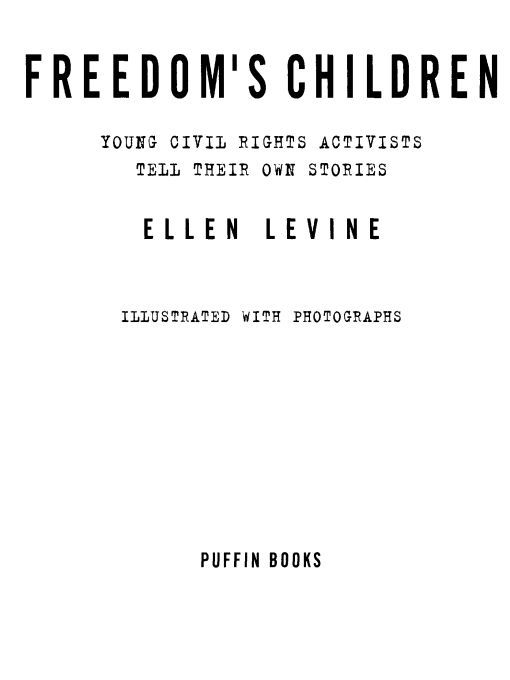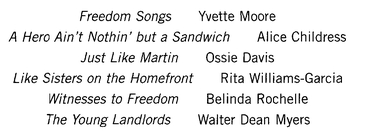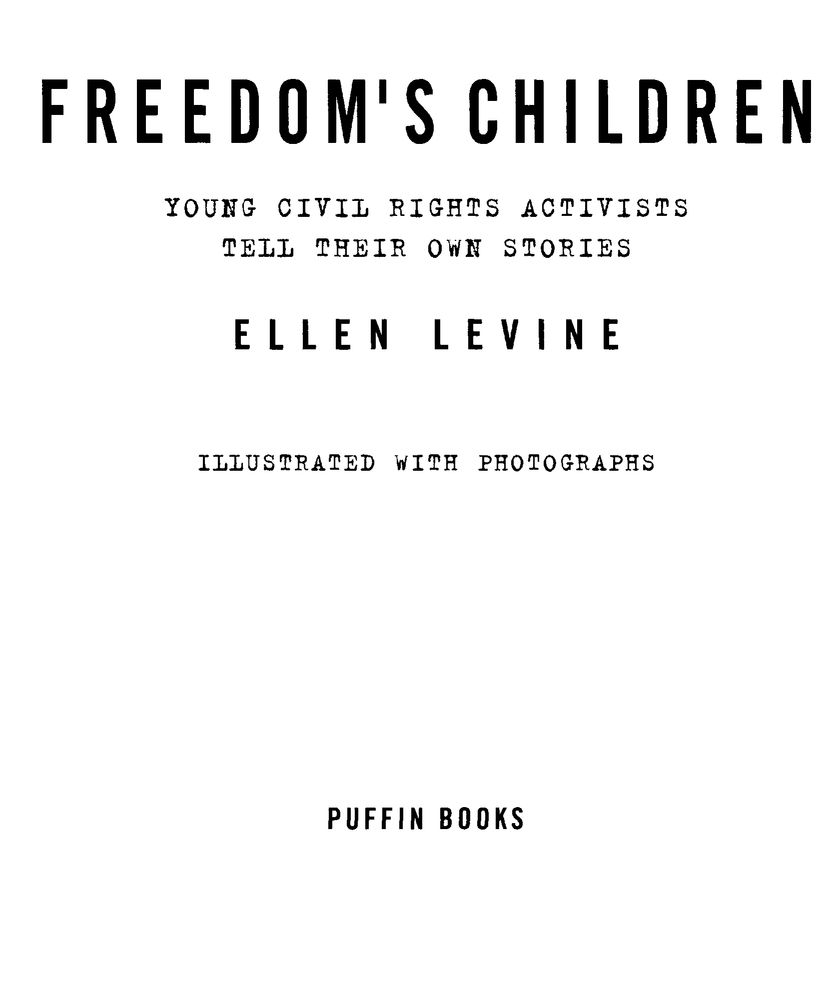Freedom's Children
Read Freedom's Children Online
Authors: Ellen S. Levine


Table of Contents
Â
Â
THEY WERE FREEDOM'S CHILDREN....
They grew up in cities and towns in Alabama, Mississippi, and Arkansas. And there were thousands more like them throughout the South. They shared a history that included the 1955 murder of fourteen-year-old Emmett Till, killed for allegedly having talked “improperly” with a white woman; and the triumph of the Montgomery Bus Boycott, when thousands of blacks stayed off the city buses for over a year to protest segregation. No matter where they came from, they knew of the Birmingham, Alabama, church bombing, “Bloody Sunday,” and the Selma-to-Montgomery march.
Although beatings, arrests, and death were an intrinsic part of the story of the movement, these are not tales of sadness and despair. To the contrary, the young people in these pages speak of a pride, a confidence, a joy at being part of something they knew was right.
âfrom the Introduction
OTHER PUFFIN BOOKS YOU MAY ENJOY


Photograph credits
Â
Â
Â
PUFFIN BOOKS
Published by the Penguin Group
Penguin Putnam Books for Young Readers,
345 Hudson Street, New York, New York 10014, U.S.A.
Penguin Books Ltd, 27 Wrights Lane, London W8 5TZ, England
Penguin Books Australia Ltd, Ringwood, Victoria, Australia
Penguin Books Canada Ltd, 10 Alcorn Avenue, Toronto, Ontario, Canada M4V 3B2
Penguin Books (N.Z.) Ltd, 182-190 Wairau Road, Auckland 10, New Zealand
Published by the Penguin Group
Penguin Putnam Books for Young Readers,
345 Hudson Street, New York, New York 10014, U.S.A.
Penguin Books Ltd, 27 Wrights Lane, London W8 5TZ, England
Penguin Books Australia Ltd, Ringwood, Victoria, Australia
Penguin Books Canada Ltd, 10 Alcorn Avenue, Toronto, Ontario, Canada M4V 3B2
Penguin Books (N.Z.) Ltd, 182-190 Wairau Road, Auckland 10, New Zealand
Â
Penguin Books Ltd, Registered Offices: Harmondsworth, Middlesex, England
Â
First published in the United States of America by G. P. Putnam's Sons,
a division of The Putnam & Grosset Group, 1993
Published by Puffin Books,
a division of Penguin Putnam Books for Young Readers, 2000
a division of The Putnam & Grosset Group, 1993
Published by Puffin Books,
a division of Penguin Putnam Books for Young Readers, 2000
Â
Copyright © Ellen Levine, 1993All rights reserved
Â
THE LIBRARY OF CONGRESS HAS CATALOGED THE G. P. PUTNAM'S SONS EDITION AS FOLLOWS:
Levine, Ellen. Freedom's children / Ellen Levine;
illustrated with photographs.
p. cm.
Includes bibliographical references and index.
Summary: Southern blacks who were young and involved in the civil rights
movement during the 1950s and 1960s describe their experiences.
1. Afro-AmericansâCivil rightsâJuvenile literature.
3. Civil rights movementsâUnited StatesâHistoryâ20th centuryâJuvenile literature.
3. Afro-AmericansâinterviewsâJuvenile literature.
4. Civil rights workersâUnited StatesâInterviewsâJuvenile literature.
[1. Afro-AmericansâCivil rights. 2. Civil rights movementsâHistory. 3. Race relations.] I. Title.
E185.615.L'.0496073âdc20 92-1358 CIP AC
Levine, Ellen. Freedom's children / Ellen Levine;
illustrated with photographs.
p. cm.
Includes bibliographical references and index.
Summary: Southern blacks who were young and involved in the civil rights
movement during the 1950s and 1960s describe their experiences.
1. Afro-AmericansâCivil rightsâJuvenile literature.
3. Civil rights movementsâUnited StatesâHistoryâ20th centuryâJuvenile literature.
3. Afro-AmericansâinterviewsâJuvenile literature.
4. Civil rights workersâUnited StatesâInterviewsâJuvenile literature.
[1. Afro-AmericansâCivil rights. 2. Civil rights movementsâHistory. 3. Race relations.] I. Title.
E185.615.L'.0496073âdc20 92-1358 CIP AC
Â
eISBN : 978-1-101-07617-0
Â
Â
For my father, Nathan Levine,
and in memory of my mother, Ide Gruber Levine,
both of whom abhorred and fought prejudice,
and took great pleasure in the fact
that their three daughters were
on the March on Washington in 1963.
and in memory of my mother, Ide Gruber Levine,
both of whom abhorred and fought prejudice,
and took great pleasure in the fact
that their three daughters were
on the March on Washington in 1963.
â Note to the Reader
Most of the text of this book is comprised of the stories the people I interviewed told me over long hours of conversation. To set the context for these oral histories, I have written introductions with background material to each chapter. In a number of instances I have felt it necessary to insert additional background information in the text of an interview. This material is printed in italics.
â
Preface
Preface
Many have asked me how I found people to interview for this book. There are thousands of southern blacks who were young and involved in the civil rights movement during the 1950s and 1960s, but with a few exceptions, they aren't famous. Precisely because of that, I wanted to tell their stories. With all the talk of the importance of “role models,” I believe that among the most powerful models for young people today are their heroic counterparts of yesterdayânot heroes on pedestals, adult and remote, but kids like themselves who believed that their world could change for the better and undertook the challenge to make the changes.
But how to find these young people? Demonstrations, boycotts, marches, and other forms of public protest were a tangible sign of involvement, and so I began with the major events from 1955 to 1965âthe Montgomery Bus Boycott, the Little Rock school integration crisis, the Birmingham protests, Mississippi Summer, Bloody Sunday and the Selma Movement. Before traveling south, I read extensively, and then began telephoning. I called churches, community groups, someone's aunt or cousin, anyone or any group I could find, searching for names of people who were children or teenagers during the movement days.
I called Montgomery, Alabama, telephone information for a listing for Rosa Parks. She wasn't a young person at the time of the bus boycott, but perhaps she could direct me to some who were. I introduced myself to the woman who answered the phone and described the project. She listened patiently and then told me she wasn't “that Rosa Parks,” but she wanted to help. She stood up at her church service and asked for names of people who were young and involved at the time of the boycott. She gave me names. Later, when I arrived in Montgomery, Gwen Patton, who tells her story in these pages, was a daily source of information and support.
Because of a casual conversation with Erma Malloy, who was sitting next to me at Howard University's oral archives, I was put in touch with Mildred Tucker, a remarkable woman who lives in Birmingham, Alabama. She called me every day when I was in Birmingham with a list of new people for me to contact.
Friends of mine who had lived and worked in Mississippi during movement days gave me the names of young people they had known. Aviva Futorian, a college friend who had spent a year and a half working first as a Freedom School teacher and then as a SNCC organizer in Mississippi, was extremely helpful. We talked almost daily during my stay in that state. Ben Chaney was most helpful in providing me with additional names. And in the way of these things, one person then led to another.
When I went south to begin interviewing, people were extraordinarily generous and helpful. Every day during the time I was there, someone would say, “I've been thinking, and I know someone who ...” And that's how I found most of the people in the book. My only regret is that I haven't been able to include the stories of everyone I talked with.
I have many to thank. First, of course, the people whose voices fill these pages. They spent many long hours talking with me, reliving a past, sharing memories of laughter, adventure, triumph, and sadness. Others helped in various ways. Some housed me during my travels, or spent time thinking of people for me to contact; lawyer friends checked citations and copied cases for me; others gave me books that were pertinent but not easy to find; family and friends were “just there” for lunch, dinner, and words of encouragement. To all of them I am most beholden: Julie Abraham, Daisy Bates, Velma Bates, Adrienne Bernard, Dori Brenner, Sara Bullard, Larry Davis, Ann Diamond, Marie Foster, Barbara Garson, Judy Hole, Annette Horwitz, Orisis Icarus, Linda Kamm, Ingrid Kindred, Lise Kreps, Susan Kuklin, Ira Landess, Bob Lavelle, Mada Liebman, Leslie McLemore, Jan Meren, Diane Nash, Phyllis Richman, Deb orah Sandford, Reverend Fred Shuttlesworth, Frank Sikora, William Singleton, Fanny Watson, Katie Watson, and Roslyn Yasser.
I am also most grateful to David Garrow, who opened his extensive files and flipped his Wheeldex to give me a long list of names to contact. And to Anne Koedt, who read, and reread, and reread the manuscript, always supportive, always insightful.
A special thanks to Frank Leonardo, who performed miracles on my ailing computer.
And finally, my deep gratitude to Refna Wilkin, my editor. Only the space restrictions she has imposed prevent my detailing her many virtues.
â
Introduction
Introduction
This book is about thirty young African Americansâchildren and teenagersâwho tell in their own words of their involvement in the civil rights movement of the 1950s and 1960s. Uncluttered by concerns of power or fame, they had the simplest and clearest of political urges, the impulse for freedom.
They grew up in cities and towns in Alabama, Mississippi, and Arkansas. And there were thousands more like them throughout the South. But wherever their homes, they had a common knowledge and shared experience of segregation, its rules, its humiliations, and its dangers.
From Montgomery, Alabama, to Itta Bena, Mississippi, there was little difference, for example, in the insulting tones of the white insurance man who, on his weekly collection visits to black homes, invariably called older black persons by their first names, while he expected to be addressed as “Mister.”
Throughout the South the “colored” water fountain was more than an abstract symbol of segregation. It was for many a daily slap in the face. The city bus signs for a “colored” section that sent black people to the back, or forced them to stand over empty “white only” seats, were a constant source of anger and frustration.
Black children throughout the South shared a history that included the 1955 murder of fourteen-year-old Emmett Till, killed for allegedly having talked “improperly” to a white woman in a small-town store in Mississippi. He “had broken that code,” one young Mississippian says in these pages. And he died for it.
They shared the triumph of the Montgomery Bus Boycott, when thousands of blacks stayed off the city buses for over a year to protest segregation. They all were aware of the landmark school desegregation decision in 1954,
Brown v. Board of Education of Topeka,
in which the United States Supreme Court declared school segregation unconstitutional. And they all knew of the Little Rock Nine, the black high school students who in 1957 faced off an hysterical white community and, under the eyes and guns of U.S. troops, finished out the school year.
Brown v. Board of Education of Topeka,
in which the United States Supreme Court declared school segregation unconstitutional. And they all knew of the Little Rock Nine, the black high school students who in 1957 faced off an hysterical white community and, under the eyes and guns of U.S. troops, finished out the school year.
No matter where they came from, they knew of the Birmingham, Alabama, church bombing in 1963, in which four young black girls were killed. Often their parents tried to stop their involvement by reminding them of the Birmingham tragedy, but they weren't deterred. And they all knew of “Bloody Sunday” and the subsequent Selma-to-Montgomery march that triggered the passage of the landmark Voting Rights Act of 1965.
Other books
Meagan by Shona Husk
Against the Law by Kat Martin
Any Means Necessary: A Luke Stone Thriller (Book 1) by Jack Mars
The 13th Step by Moira Rogers
Cowboys In Her Pocket by Jan Springer
Call My Name (Fallen Angels MC Book 3) by Laura Day
Jumping Puddles by Rachael Brownell
Hot & Spicy: De La Cruz Saga by Macias, P. T.
Cody's Army by Jim Case
New Alpha-New Rules by By K. S. Martin